MIN04 Lecture, October 2nd 2018
Cellular automata
Simple models of dynamic interactions in 2D
Inge Wortel
inge.wortel@radboudumc.nl
Department of Tumor Immunology, Radboudumc


The ultimate question: what will happen next?
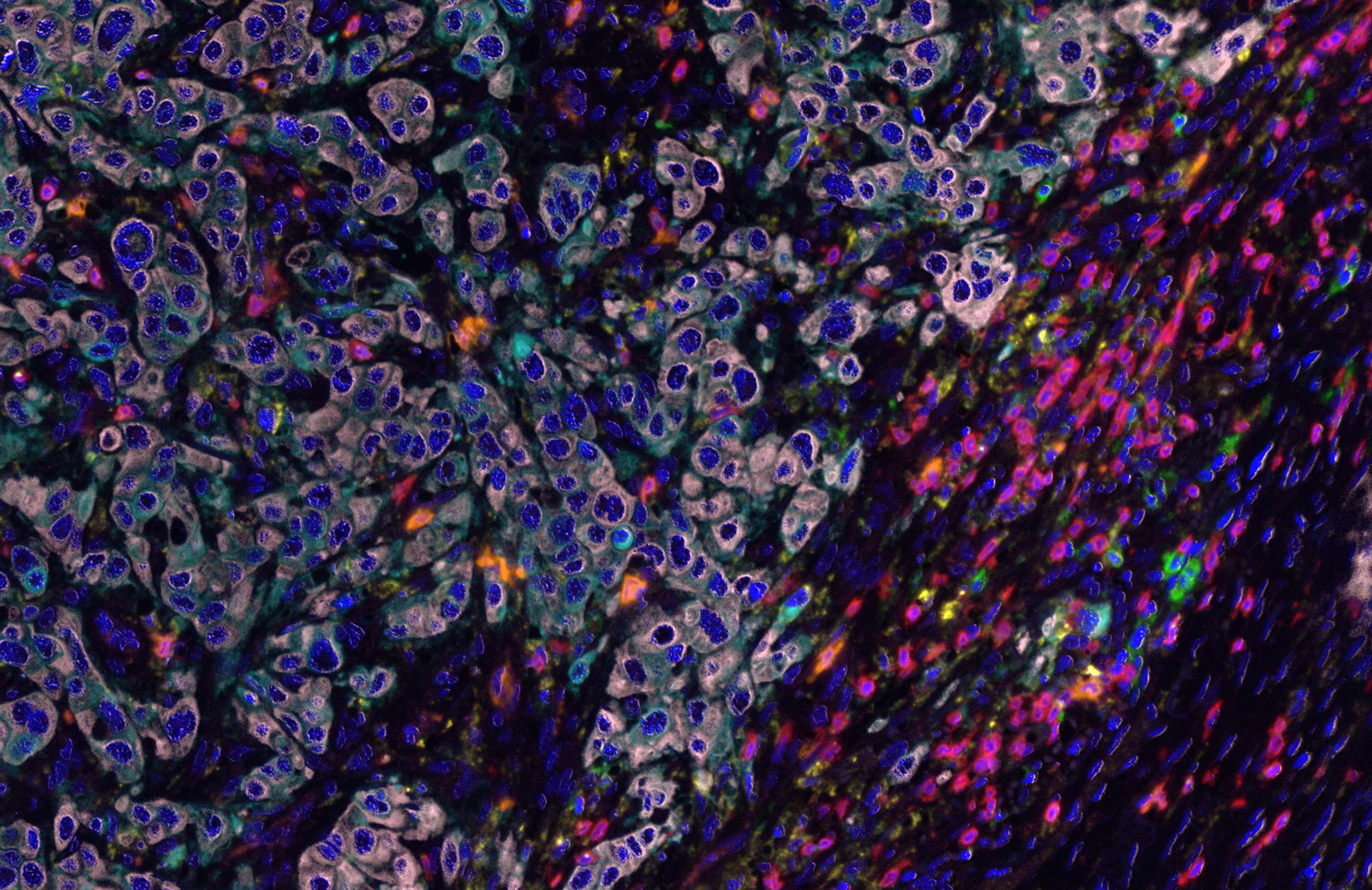
Figure: Mark Gorris, published in The Journal of Immunology ji1701262 (15 November 2017)
The tumor microenvironment (TME)

- Consists of tumor, immune, and stromal cells
The tumor microenvironment (TME)
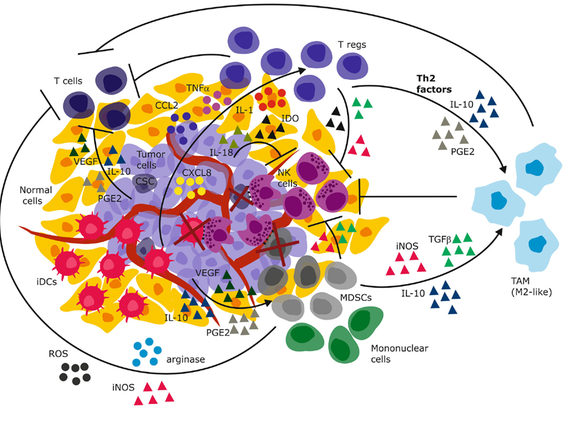
Figure adapted from: Frontiers in Immunology volume 6, article 202 (29 April 2015)
- Consists of tumor, immune, and stromal cells
- These cells interact via direct contact or diffusing chemicals
- Location matters!
Modeling in time and space
Yesterday:
- ODE models can help predict how a system develops over time
- We can use them e.g. to model how fast a tumor grows
- But: these models contained no info on cell location!
Today:
- How do we make models with spatial information?
- Morning: simple spatial models - cellular automata
- Afternoon: more complex models - towards modeling the TME
Cellular automata
Cellular automata are simple spatial models:
- They consist of pixels on a grid
- These pixels can have different states
- These states change over time according to some rules.
Example: bacterial colony growth (very simple model):
- Grid represents a 2D petridish
- Pixels can have two states: they contain bacteria (black), or they don't (white)
- Rule: any white pixel adjacent to a black pixel becomes black as well.
| Think, pair, share (5 min) | |
|---|---|
| How will the colony in the upper right corner of this slide grow? Is that realistic? Can you think of some way to improve this model? |
Rules do not have to be deterministic
You might argue that pixels with more infected
(black) neighbors are more likely
to become infected, so let's change our rule:
$\rightarrow$ chance of becoming black = # black neighbors x 10%
| Definition |
|---|
| We call a model deterministic if the same starting point always leads to the same result. Otherwise, we call it stochastic. |
| . |
| Key Point |
|---|
| We can make many different cellular automata by inventing new rules. |
Another model: how does infection spread in a population?
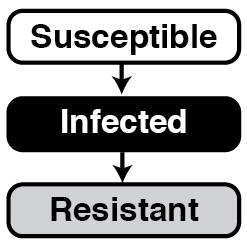
The SIR model: individuals can be
- Susceptible
(= healthy, but they can still become infected) - Infected
- Resistant
(= healthy, and can no longer be infected)
| Think, pair, share (5 min) | |
|---|---|
| How would you convert this model into a cellular automaton? What should the grid represent? And the states? What rules can you come up with, and are they deterministic or stochastic? |
SIR model as cellular automaton

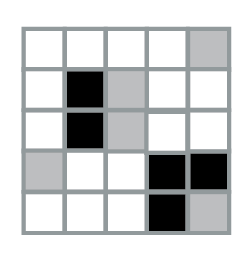
Grid and states:
- Each position on the grid is an individual
- Three states: susceptible, infected, resistant
Rules:
- A susceptible individual becomes infected with a probability depending on #infected neighbors (like before)
- An infected individual can spontaneously be cured and become resistant. The probability that this happens is a fixed chance pcure (also called recovery rate).
Exercises
| Try it yourself |
|---|
| Go to computational-immunology.org/sir/, and use the SIR model simulator to answer the questions in the exercise sheet (see Brightspace). |
The game of life
In Conway's "game of life", pixels on a grid follow 4 simple rules:
- Black pixels with 0-1 black neighbors: black $\rightarrow$ white
- Black pixels with 4-8 black neighbors: black $\rightarrow$ white
- White pixels with 3 black neighbors: white $\rightarrow$ black
- All other pixels stay the same color
| Example: | Neighbors: | Result: | |||||||||||||||||||||||||||||||||||||||||||||||||||||||||||||||||||||||||||
|
|
|
|
| Question | |
|---|---|
| Is this model deterministic or stochastic? |
The game of life
| Exercise (5 min) |
|---|
What will the three grids below look like after one step? Rules:
|
| . | . | . | |||||||||||||||||||||||||||||||||||||||||||||||||||||||||||||||||||||||||||
| A
|
B
|
C
|
|
|
|
|
Simple rules, simple behavior?
The rules are pretty simple, so can we predict what will happen in the long run?
| Think, pair, share (5 min) | |
|---|---|
| What will be the end result if we play the game of life long enough? Will we have only black, only white, or both black and white pixels? Will there even be an "end result", or will the grid keep changing? |
Simple rules, simple behavior?
The same rules can yield very different behavior depending on initial setup:
| Static | Oscillating | Migrating | ||
|---|---|---|---|---|
| |

|

|
||

|
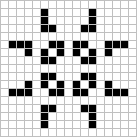
|

|
Examples from: https://en.wikipedia.org/wiki/Conway%27s_Game_of_Life
Simple rules, simple behavior?
The end result can be pretty complex...
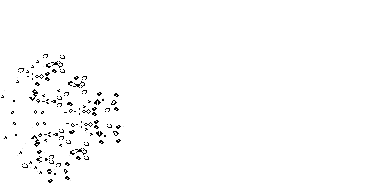
| Key Point | |
|---|---|
| Even with simple rules, it can be hard to predict what happens over time! |
Examples from: https://en.wikipedia.org/wiki/Conway%27s_Game_of_Life
Exercises
| Try it yourself |
|---|
|
Go to https://bitstorm.org/gameoflife/,
and use the game of life-simulator to answer the questions in the exercise sheet
(see Brightspace).
Please skip exercise 3.2.4. |
.
Coffee break
| Question |
|---|
| How do you think a zebra gets its stripes? |
 |
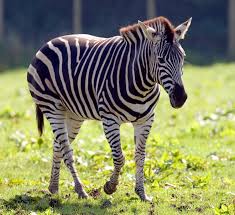 |
Spatial patterns in biology
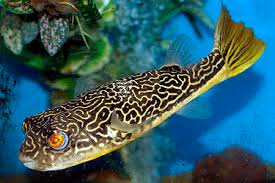 |
 |
 |
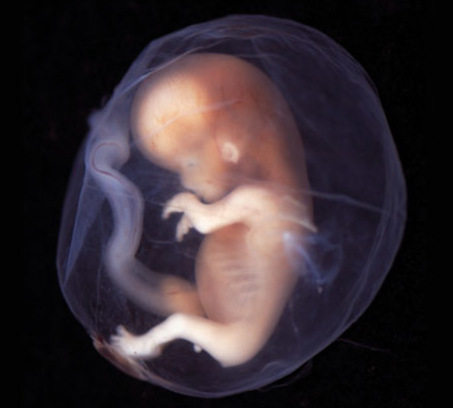 |
 |
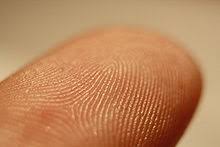 |
Alan Turing
- Mathematician, computer scientist
- Invented some of the fundamental concepts of computer science, including the idea of a "programmable computer"
- Famous for cracking the enigma code during WWII
- Also the founding father of theoretical biology!

|

|
| Alan Turing (1912-1954) |
Movie (2014) |
Turing patterns
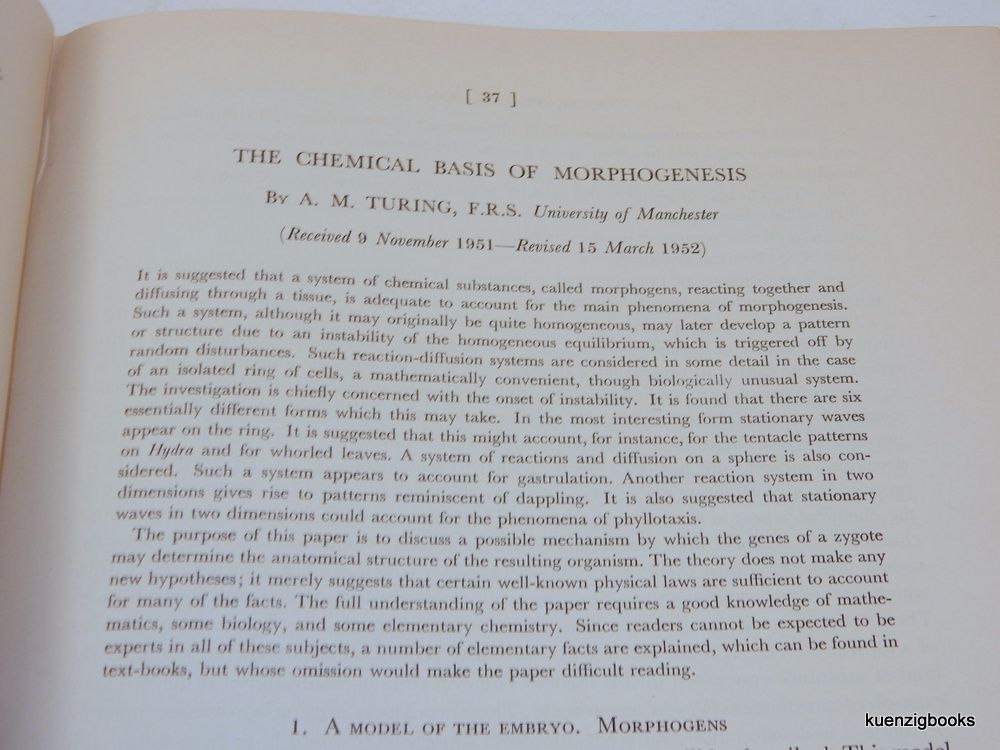
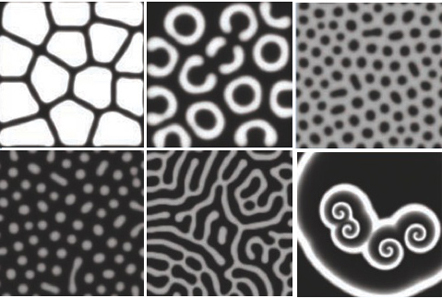
Turing wondered how symmetry breaking can occur in an organism (morphogenesis). He predicted that a reaction-diffusion system could do the trick if:
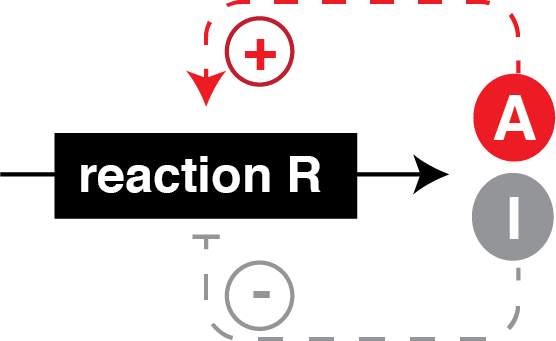
- Reaction R produces molecules A and I
- Molecule A activates reaction R
- Molecule I inhibits reaction R
- Molecule I diffuses much faster than A
These reactions exist: Belousov-Zhabotinsky reaction
Turing patterns
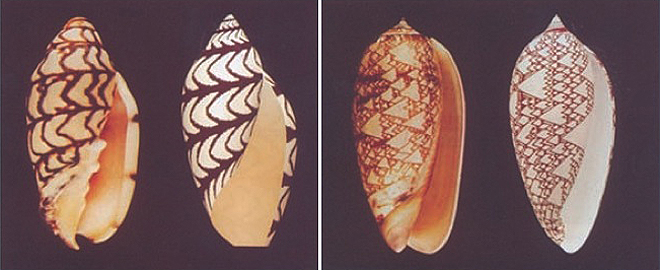
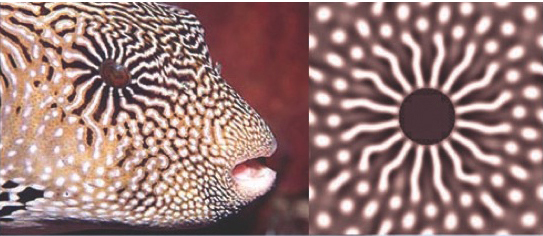
Turing himself had to do all computations by hand, but computers can now simulate patterns found in nature!
The Gray-Scott model
Another diffusion-reaction model that produces patterns: the Gray-Scott model
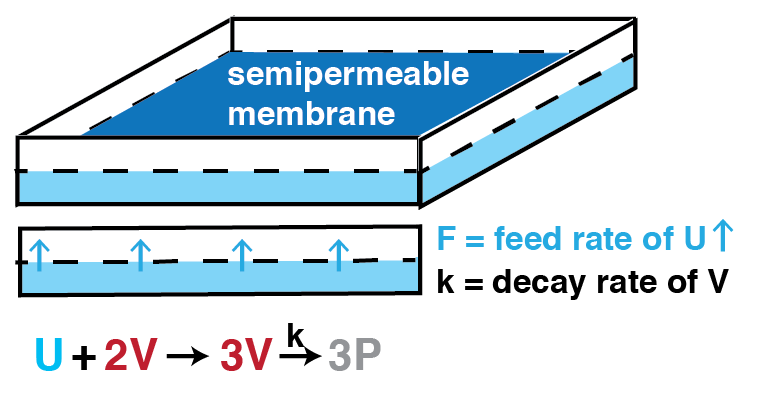
- Molecule U reacts into molecule V
- Reaction is catalyzed by 2 molecules of V
- V decays into a waste product P at rate $k$
- New U is supplied through a semi-permeable membrane at rate $F$
- Both U and V can diffuse
The Gray-Scott model as a cellular automaton

The grid:
- We now need 2 grids instead of 1 (1 for U, 1 for V)
- We have not just a few states, but many (states represent the amount of V and U)
The Gray-Scott model as a cellular automaton

So what about the rules? They should represent several processes:
- New supply of U
- Diffusion
- Reaction of U to V
- Decay of V
| Exercise (5 min) | |
|---|---|
| For each of the processes above, consider a position (pixel) p on the grid. On which grid(s) should the value G(p) at position p be updated (U, V, or both)? Which information (in the current grid of U, V, or both) should we use to determine what the updated value G*(p) should be? |
The Gray-Scott model as a cellular automaton
Diffusion:
- Molecules diffuse independently of each other (U $\rightarrow$ U* and V $\rightarrow$ V*)
- G*(p) depends on G(p), but also on G(neighbors of p)
- G*(p) $\sim$ average of G(pi), for pi = p and all its neighbors in current grid
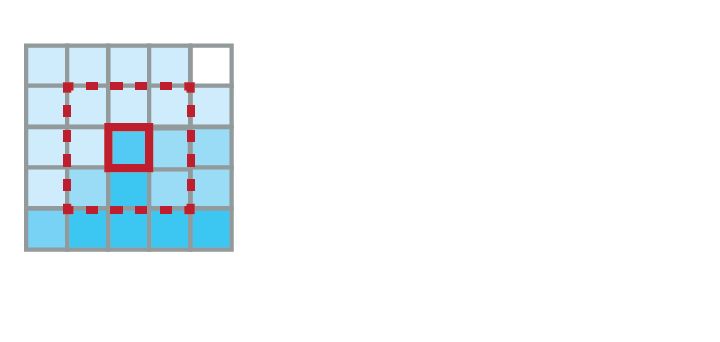
Supply of U:
- New U is supplied by diffusion through a semi-permeable membrane!
- U*(p) $\sim$ average of U(p) and Usupply
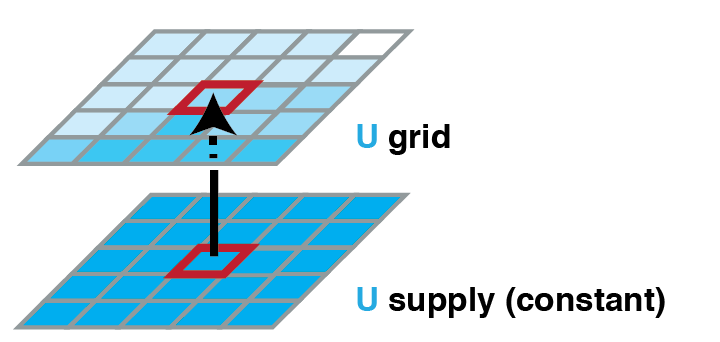
The Gray-Scott model as a cellular automaton
Reaction U $\rightarrow$ V:
- Depends on amount U(p) and amount V(p) at p
- A percentage x of U(p) reacts. This percentage depends on V(p).
- U*(p) = U(p) - x,
V*(p) = V(p) + x
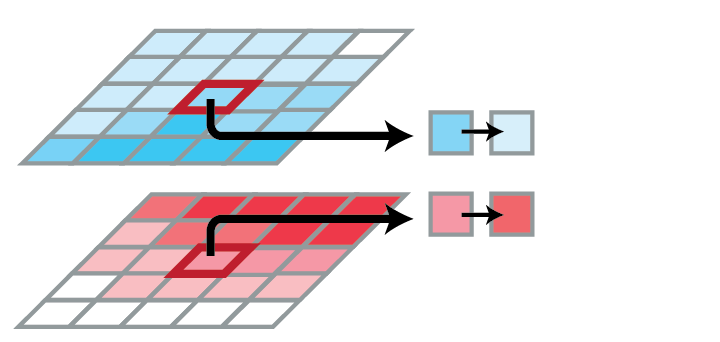
Decay of V:
- Depends only on the current amount of V
- New value at p = percentage of current value

The Gray-Scott model: predictions
Different patterns are possible in this model:
Exercises
| Try it yourself |
|---|
| Go to https://mrob.com/pub/comp/xmorphia/ogl/index.html, and use the Gray-Scott simulator to answer the questions in the exercise sheet (see Brightspace). |
Summary
Cellular automata:
- We can build a cellular automaton by defining a grid, the possible states, and some rules to determine what the next state will be
- Rules can be deterministic or stochastic
- They can depend only on one position p, or also on its neighbors
- We can have multiple grids that communicate with each other
This afternoon: discuss even more complex models to simulate migrating cells
| Discussion |
|---|
| We have seen that a combination of simple rules can already yield complex behavior, so that it is not always intuitive to predict what will happen over time. What do you think that means for research into the TME? |